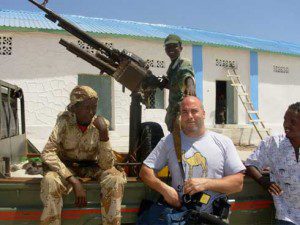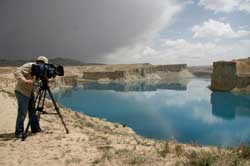Behind the Lens
Camera operators in war are often eclipsed by the images they capture. Here are some of the stories of the people outside the frame
Like an international aid worker, a cameraman in a conflict zone is a saviour to some and a target to others. When he pulls out his gear in a war-torn village, he’s instantly a local attraction, drawing crowds of curious onlookers and locals looking to broadcast their frustrations. But he can’t stay in one place for longer than 10 to 15 minutes or he’ll become a target for anyone wanting to make a statement against the West. His camera may also be mistaken for a rocket launcher, inviting hostile military attention from all sides of a conflict.
Back in Canada, the same individual is more or less invisible. Canadian viewers may see war footage on the nightly news but don’t hear anything about the person who filmed it. Perhaps, while on the job, he was shot at by Serbian soldiers on the front lines in Bosnia, like freelance cinematographer Michael Grippo. Or maybe Iraqi thieves rushed his vehicle the moment it slowed down on a highway, like Jeffery Stephen of Global National. Or possibly he found himself following an Afghani mine clearer in order to get a good angle, like CBC’s Ed Middleton. But viewers will only see the video clips that come out of these trips, allowing them to visualize wars, humanitarian crises or environmental catastrophes happening worlds away.
Camera operators have been risking their lives for decades to send back such footage, generally with little recognition. According to the New York-based Committee to Protect Journalists, camera operators made up about 10 percent of the 713 journalists killed on the job since 1992. And that number doesn’t include the close calls, of which there are many.
Doug Vogt, a Canadian cinematographer at ABC News, half-jokes that he’s only become interesting to publications like the Review since his brush with death in 2006. After 23 years of filming in conflict zones, he and ABC News anchor Bob Woodruff were injured by a roadside bomb in Iraq. The two were sitting atop an armoured vehicle in a military convoy when the improvised explosive device (IED) went off next to them, throwing Woodruff into the cockpit and hurling Vogt flat on his back on the vehicle’s roof. Vogt regained consciousness quickly, but was unable to move. Afraid of the crossfire and worried that the Iraqi driver would step on the gas and send him flying, Vogt managed to shift his feet closer to the hatch so he could be pulled safely inside.
“When I got into the tank I was organized enough to collect my cameras,” Vogt remembers. He didn’t realize at the time that his skull was fractured. Vogt now compares his head injury to a window shattering, with broken pieces of bone penetrating his brain, along with the usual rocks and flak that fly out of an IED. Despite being airlifted to a military hospital and undergoing brain surgery within the hour, it took him almost a full year to recover. He has since sworn off war zones but he can still readily explain what motivated him to take on these jobs. He’s fascinated by the way war affects civilians and the idea that, in being present in these places, camera operators can witness history. He says, “You’re seeing fantastic things with your own eyes.”
Global’s Jeffrey Stephen, another veteran of international conflict areas, insists he’s clear-headed when he accepts these risky assignments. “It’s just an amazing thing to take part in an international story,” he says. “It’s addictive.” Grippo, who has covered so many conflicts he has difficulty remembering the chronology of his travels, remains clear about his reasoning for going to places like Haiti, Sierra Leone, Bosnia and Iraq: “You end up thinking at the time that maybe, if someone sees my documentary, maybe this will help it stop [the suffering].”
For an audience to care about the plight of people living thousands of miles away, photos and footage are paramount. As Global’s Middle East correspondent for Global National, Lauren McNabb, puts it, “The experience of a cameraperson makes all the difference in the stories you tell.” Using the example of Burma, where she travelled last May after the cyclone, McNabb says, “Who would have known how bad it really was if those people weren’t there taking pictures?”
In many cases, the pictures themselves are the hardest part. Along with conflict and catastrophe come death and anguish. And a cameraperson, unlike an anchor, doesn’t have the option to look away. The experienced ones use the camera as a buffer and concentrate solely on the angles, lighting and other details while filming a difficult scene. Paul Seeler, who works for CBC’s the fifth estate, says it was largely the camera itself that helped him get through his job at the Kandahar base hospital in Afghanistan in January 2008. “There’s kind of a distancing when you put the lens up to you,” he explains, referring to his extensive footage of dead bodies and surgeries. Despite this, he says, you have to build up a tolerance to smells. Some camera operators he knows spread Vicks VapoRub on their upper lip to mask foul smells from open wounds and corpses. “Sometimes at the end of the day,” he says, “you need a stiff drink or a long walk.”
This ability to remove themselves emotionally is another part of what makes camera operators so vital during a shoot. McNabb, who has worked with Stephen on productions all over the world, says she heavily relies on his judgment in dangerous situations. Now, she has had a lot of overseas experience, but early on in her travels it was always the cameraperson who would reassure her about where gunfire was coming from or whether they should go ahead with a shoot in a dangerous spot.
Still, as many camera operators point out, they’re not cowboys. Grippo speaks nonchalantly about the dangers he has faced, but admits he has been fearful and nervous on many occasions. As he explains, though, the fear and the exhilaration are part of his job-not to mention that when it’s over he gets to go home. He says he can’t help but think about the people left behind in conflict zones, who are vital to the production of the news-the translators he works with, the drivers. He says, “You want to tip your hat to them.”
















